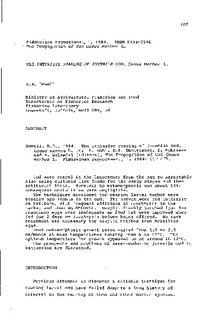| dc.contributor.author | Howell, Bari R. | |
| dc.date.accessioned | 2008-08-06T14:03:18Z | |
| dc.date.issued | 1984 | |
| dc.identifier.issn | 0333-2594 | |
| dc.identifier.uri | http://hdl.handle.net/11250/115132 | |
| dc.description.abstract | Cod were reared in the laboratory from the egg to marketable
size using cultured live foods for the early stages and then
artificial diets. Survival to metamorphosis was about 10%;
subsequent mortalities were negligible.
The techniques developed for rearing larval turbot were
broadly applicable to the cod. The larvae were fed initially
on rotifers, with frequent additions of lsochrysis to the
tanks, and then on Artemia. Nauplii freshly hatched from San
Francisco eggs were inadequate as food but were improved when
fed for 2 days on lsochrysis before being offered. No such
treatment was necessary for nauplii hatched from Brazilian
eggs. Post-metamorphosis growth rates varied from 1.9 to 2.8
cm/month at mean temperatures ranging from 6 to 17 degrees C. The
optimum temperature for growth appeared to be around 10-12 degrees C.
The prospects and problems of mass-producing juvenile cod in
hatcheries are discussed. | en |
| dc.format.extent | 398622 bytes | |
| dc.format.mimetype | application/pdf | |
| dc.language.iso | eng | en |
| dc.publisher | Havforskningsinstituttet | en |
| dc.relation.ispartofseries | Flødevigen rapportserie | en |
| dc.relation.ispartofseries | 1, 1984 | en |
| dc.title | The intensive tearing of juvenile cod, Gadus morhua L. In: The propagation of cod Gadus morhua L.: an international symposium, Arendal, 14 - 17 June 1983 | en |
| dc.type | Conference object | en |
| dc.source.pagenumber | 657-676 | en |
